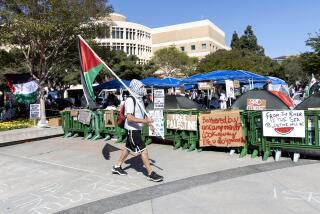Wheelchair Access Called Inadequate : CSUN: Student’s complaint prompts school to agree to make $20,000 in changes at new building.
- Share via
NORTHRIDGE — Despite Cal State Northridge’s national reputation for serving the disabled, the campus’s new business and education complex has numerous flaws that limit access for people in wheelchairs, the university has conceded in response to a student’s federal discrimination complaint.
Campus officials have agreed to spend about $20,000 to correct problems with doors, bathrooms and drinking fountains, although they maintain that the building complies with federal regulations. But Susan Jolly and her backers say the $24-million complex violates the Americans with Disabilities Act; they are demanding even broader changes.
“This is a brand-new building. How could they not make it accessible?” said Jolly, 27, an accounting major who was left a quadriplegic by a car accident eight years ago. Jolly maintains that she was unable to get in and out of classrooms, offices and even bathrooms in the business building, or even use its drinking fountains.
She filed a complaint with the U. S. Justice Department in late February. Because the campus has yet to begin most of its promised modifications, the Van Nuys-based Independent Living Center of Southern California, a disabled rights group, joined Jolly’s fight by lodging its own federal complaint on Friday.
The complaints are a required step before lawsuits may be filed and are usually settled through a process of mediation.
Although Jolly’s complaint deals only with the four-story business building, the center alleges similar problems affecting the entire four-building, nearly 200,000-square-foot business and education complex, the newest facility on the 353-acre campus.
“Cal State Northridge is not the only one with these problems, but that doesn’t give them an excuse,” said Norma Jean Vescovo, the center’s executive director.
CSUN officials say the complex was designed in the late 1980s before new access requirements took effect in January, 1992, under the landmark Americans with Disabilities Act. The business building opened in November, after time-consuming earthquake repairs.
“That building met all the requirements of the previous regulations. We’re doing more than we’re required to do,” said Mary Ann Cummins Prager, who oversees the school’s compliance with the law.
Not so, claims the center, which notes in its complaint that an earlier federal law compelled many colleges to provide the sorts of structural access required by the new disabilities provision--a contention that federal officials affirmed.
The earlier measure, the Rehabilitation Act of 1973, imposed disability-related requirements on public entities such as CSUN that received federal funds. After President George Bush signed the Americans with Disabilities Act in 1990, those provisions were expanded to the private sector.
Irene Bowen, deputy chief of the Justice Department’s disability rights section, said she could not comment on the specifics of the CSUN issue. But for federally funded publicentities including state colleges, she said, “The standards have been the same for a long time. Before 1992, they were very similar to what’s in place now.”
A spokesman for the architectural firm that designed the complex said he was not familiar with the Rehabilitation Act requirements and that the buildings were planned only according to the state building code.
“We were not asked to read the federal anything. I was using the state codes,” said Ernest Grant, who was project manager for Leidenfrost/Horowitz and Associates of Glendale.
Grant said the project went out to bid for construction in mid-1991 so it would not have been covered by the new Disabilities Act. Nonetheless, the prior federal law was in effect, according to the complaint filed by the center.
Regardless of the complaints’ outcome, their allegations are clearly embarrassing for the Northridge campus, where administrators have long prided themselves on catering to the needs of disabled students. They account for nearly 1,000, or 4%, of the campus’s 24,000 total enrollment.
About 50 of those students use wheelchairs, said Steve Loving, coordinator of CSUN’s Office of Disabled Student Services. (Another 300 students have learning disabilities, and almost as many are hearing impaired.)
Northridge in the mid-1960s became one of the first mainstream universities in the country to accept deaf students into regular academic programs. In 1972, the campus founded its highly lauded National Center on Deafness. CSUN also operates a Center on Disabilities that focuses on how technology can be used to advantage.
Yet Jolly’s complaint is hardly the campus’s first brush with disability controversy. Just last fall, deaf students and staff complained that low wages and poor working conditions were driving away talented interpreters. Months later, the interpreters have yet to negotiate a new labor agreement.
“This campus is as sensitive as any I’ve seen, yet the situation with the business building shows we’re not perfect,” said CSUN spokesman Bruce Erickson.
After a contingent of university officials toured the business building with Jolly in early February, they agreed that her complaints were justified and promised to remedy most of them. The work should be completed by June.
Jolly, a transfer student from Florida who uses an electric wheelchair, only began at CSUN last fall, when most classes were being held in hundreds of portable bungalows because of widespread damage from the Northridge earthquake.
Yet Jolly said she never had a problem gaining access to the temporary classrooms, largely because campus officials made adding wheelchair ramps a priority. All that changed in mid-November when her accounting class was shifted into the permanent business building that had just been repaired.
Jolly said she quickly encountered doors that were too hard for her to open; restroom entrances that left her wheelchair trapped between double doors; classrooms with amphitheater-style seating but no ramps, and even drinking fountains she could not operate.
On one occasion, she became stuck in a corridor on the building’s fourth floor for nearly half an hour, unable to open a set of manual double-doors that led into an area of faculty offices. And Jolly, who can use her arms but not her fingers, said she considers herself independent.
“The architect made the building for looks. It’s pretty to look at,” said Jolly, who is now pregnant, bedridden and taking a leave of absence from classes and her job at the center.
“But no one really thought through the law. I feel like whoever was the architect did not know accessibility codes very well. These things should have been worked out.”
Changes will include adjusting the pressure on doors to make them easier to open, installing automatic door systems, and changing bathroom doors and sink fixtures. The drinking fountains will also be adjusted and the controls on existing automatic door openers--which Jolly had complained were too high--will be lowered.
Still unresolved is whether to change the amphitheater seating in classrooms.
Jolly wants the rooms, which now have only one wheelchair-accessible seat apiece, to be broadly reconfigured. But Cummins Prager said the university doesn’t have the funds for that. Instead, classes in rooms with access problems will be relocated starting in the fall.
More to Read
Sign up for Essential California
The most important California stories and recommendations in your inbox every morning.
You may occasionally receive promotional content from the Los Angeles Times.










